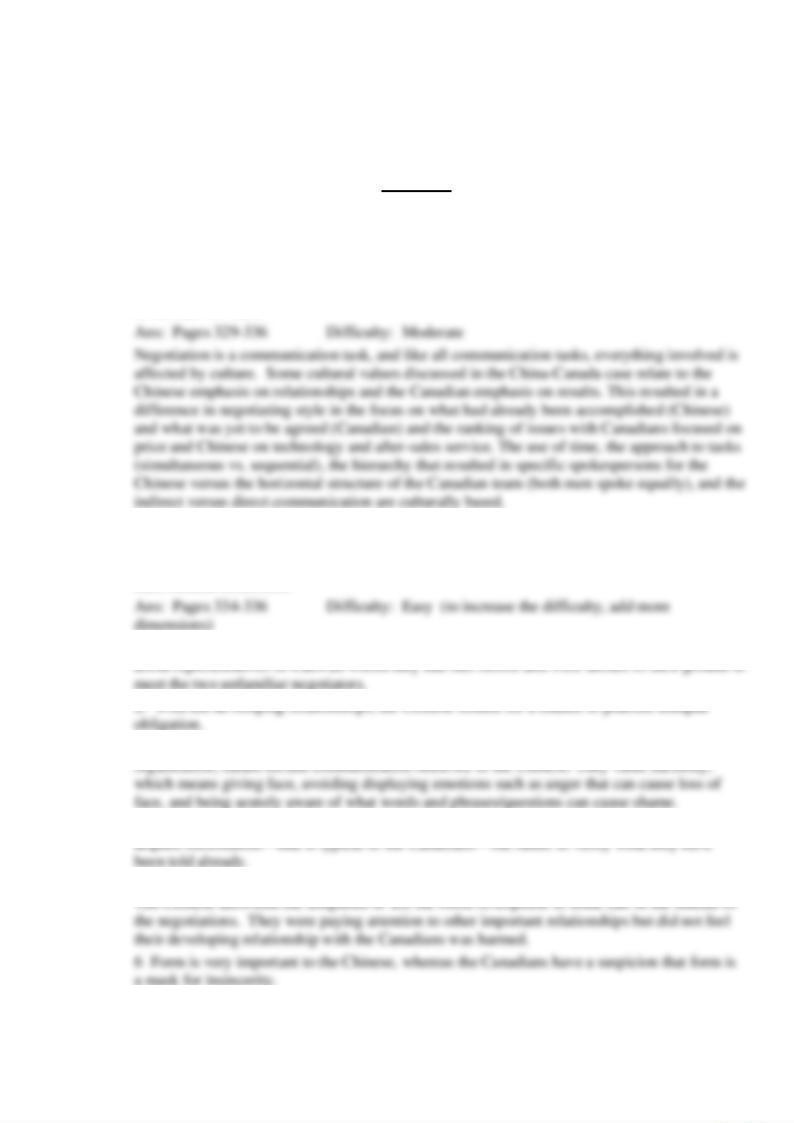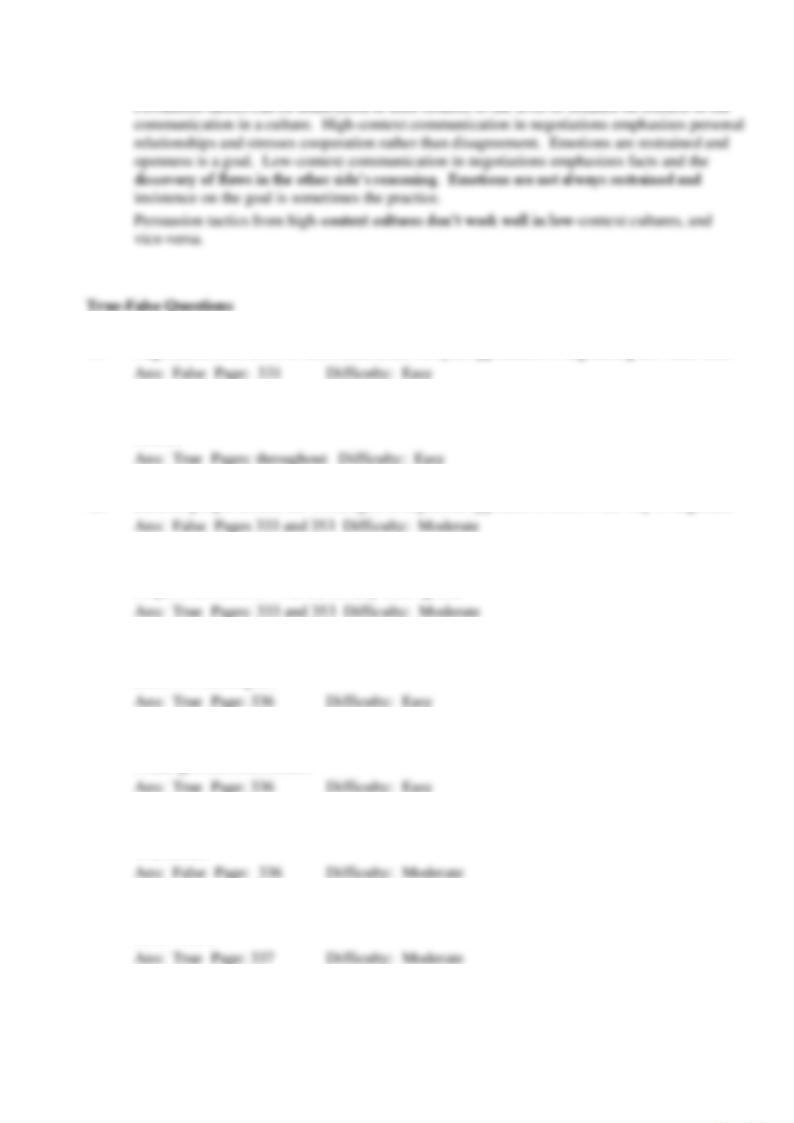
CHAPTER 9
INTERCULTURAL NEGOTIATION TEAMS
Test Bank
Essay Questions
1. How can knowledge of culture help a negotiating team reach a successful outcome? Using
cultural values from the dimensions you have already learned, discuss the negotiating behavior
in the Canwell case.
2. In the Canwall case, approximately ten of the 24 cultural dimensions from Chapters 3 and 4
came into play. Discuss at least 5 of them, explaining the Chinese or Canadian position on
each cultural dimension.
1. The Chinese value relationships; the Canadians value results. The Chinese kept asking
3. Permanent group membership, including membership in a relationship with another
4. Question-asking by the Chinese is not a learning method, so frequently it is done not to
5. The Chinese perform tasks simultaneously, which seemed to the Canadians to be rudeness.

8. Access to authority is mediated in Chinese culture, so the authority figures with the most
9. The Chinese had an interdependent self-construal; team members viewed themselves as part
10. The Chinese appeared more flexible about uncertainty and were able to explore a
3. Discuss differences in the roles taken by members of negotiating teams from individualist
cultures and compare them with roles on teams from collectivist cultures. In particular, refer to
roles of leader-surrogate, suggestion-maker and consultant in a collectivist-culture team, and
skeptic, recorder, and gatekeeper in a team from an individualist culture.
4. Discuss expectations for negotiation outcomes. The three components you should address are
goals, notions of fairness, and the three outcomes.

having access to distribution networks, and so on. Goals also involve establishing an ongoing
5. Discuss how the team orientation—strategic or synergistic—and the criteria for selecting
members (high status, special expertise, translator) reflect cultural values.
6. Describe how three nonverbal factors--site/space, agenda, and use of time--affect negotiation
outcomes.
7. Negotiation is a special communication task that has specific characteristics and factors. Six
factors include focus, honor, verbal style (direct or indirect), form, emotion, and silence.
Discuss two with reference to two contrasted cultures.

position, however. The worded communication style may be direct or indirect, which is
8. Define and discuss the four phases in negotiation. Use examples to show how cultures view
each phase differently.
9. Discuss argumentation styles for persuasion that vary from culture to culture. Use specific
examples from different cultures.

Persuasion tactics can be understood in their relation to the level of reliance on context of the
10. Negotiation boils down to mere differences in style; approaches to negotiating are value-free.
11. Cultures that emphasize relationships may negotiate differently from cultures that emphasize
results.
12. Businesspeople around the world agree a sequential approach to items is the way to negotiate.
13. It appears that members of cultures in which harmony has a high priority will negotiate with
frequent reference to what has already been agreed.
14. A team is composed of two or more people who interact and coordinate their work to
achieve a shared goal.
15. Organizations form teams in order to have better results for their strategies and goals than they
would get from individuals.
16. Organizations employ teams frequently, although they do not see effective decision-making
with teams.
17. Individuals value being on teams because they want to develop a record of cooperative
achievement.

18. A record of cooperative achievement shows relational effectiveness, according to some
scholars.
19. In individualist cultures, team members can fill between 5 and 9 roles.
20. In collectivist cultures, team members can fill between 10 and 15 roles.
21. The role of consultant—a person who confers with other team members outside of meetings to
ensure their opinions are addressed—is a typical role on teams from individualist cultures.
22. Note-taking and keeping a record of all that has been said and decided is not as important in
collectivist teams.
23. In considering task effectiveness, we can see that often communication among members of
teams from collectivist cultures often leads to other-face concerns being considered in choice
of topic for discussion.
24. Own-goal concerns prevail in the communication of collectivist-culture teams.
25. Everybody around a negotiating table understands compromise: each party gives a little and
gains a little, in a fifty-fifty agreement that is fair to both sides.
26. Translators do not need to know the terminology of an industry, as long as they have a general
competence in the country’s official language.
27. Members can be chosen for a negotiating team because they are relatives of someone of high
status.
28. Negotiators who are guests in another country have the advantages of convenience and well
being, since they are treated specially.

29. All negotiating teams want to diffuse conflict.
30. Skilled Western negotiators use a technique called “enlarging the pie”—adding items to what
is already on the table as a way of enabling the other side to win, too.
31. Which statement is NOT true of negotiating?
a. it is value free
b. it is a special communication task
c. it occurs when two or more groups have common interests and disagreements about
achieving them
d. it is not static but is dynamic
32. In the case study that begins Chapter 9, the Chinese emphasized
a. getting results
b. giving their team members equal speaking time
c. establishing trust for a sound relationship
d. speaking through interpreters
33. Which of the following is NOT a role played by team members in collectivist-culture teams?
a. leader
b. skeptic
c. implementer
d. specialist
34. Which of the following is NOT discussed in Chapter 9 as one of the three areas of team
effectiveness, from a team member’s view?
a. personal effectiveness (sense of satisfaction)
b. task effectiveness (achieving a satisfactory outcome from the team’s work)
c. relational effectiveness (achieving cooperation that enables members to work together
in the future)
d. global effectiveness (achieving an organizational presence in international
environments)

35. When collectivist and individualist teams negotiate:
a. both teams, regardless of culture, rank issues the same
b. both teams have the same attitude about using time efficiently
c. both teams have a desire to "win"
d. both teams begin with generalities and continue using general references
36. Expectations for negotiation outcomes may include:
a. long-term relationships
b. winning
c. written contracts
d. all of the above
37. Members of negotiating teams are chosen for these reasons, EXCEPT:
a. relationships to high-status people in the organization/country
b. technical expertise
c. friendly openness to a foreign culture
d. language proficiency
38. The physical location of negotiations can impact their outcome because:
a. the host team has an advantage: all their resources are available to them.
b. the guest team has an advantage: they are free from the stress of the demands of daily
work
c. the host team is exhausted from preparations, which gives the guest team an advantage
d. the guest team may have adjustments to make for time, climate, and food, which puts
the host team at a disadvantage
39. How communication is worded in negotiation can affect outcomes because:
a. negotiators may become offended if they believe their group's honor is being criticized
b. negotiators may become offended if they believe enough attention is being paid to
correct form
c. negotiators may become offended if words are too long
d. all of the above
40. The phases of negotiation, regardless of culture, include:

a. quickly establishing a relationship with the other side so both sides can go on to the real
substance of the negotiations
b. exchanging information about objectives so each side can go on to try to persuade the
other
c. getting concessions so an airtight, detailed contract can be drawn up thus successfully
concluding the negotiations
d. all of the above